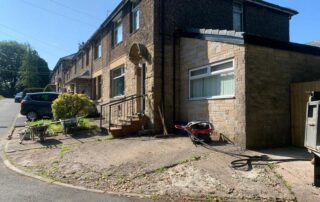Although most of us automatically associate a driveway with dimensions similar to a motorway, it is important to remember that other shapes exist. This often occurs within properties that are forced to deal with limited amounts of space. A recent project in Blackburn clearly illustrates the challenges associated with paving a curved driveway. As always, our team of professionals was up to the task. Let us take a quick look at what this work involved in order to fully appreciate the outcome.
Preparation
The outcome of any landscaping project is directly determined by the preparatory steps which are taken in advance. Once we consulted with the customer, the real work began. As there was existing material in place, the first step involved the use of a small excavator. This proved to be the best way to remove all debris and detritus that was present. We could then access the subsurface.
Even through this driveway was on a slight incline, it still needed to be levelled to a specific angle. This is essential in terms of drainage, as water may otherwise pool in unwanted areas. We then mechanically compacted the underlying soil so that the bricks were provided with a hard and flat surface.
Laying the Brick Work
One of our most popular brick paving options involves the use of an intricate herringbone pattern. In this case, the customer desired a further sense of dimension through the use of different hues. We therefore decided to work with shades of grey and red. These provided a nice visual touch while helping to break up the visual appearance of the driveway.
Each stone was put in place by hand so that even the most precise angles could be accommodated. One of the issues associated with herringbone patterns is that they require a significant amount of professional skill and expertise. Technicians begin in the centre of the driveway and work their way towards the periphery; always keeping the unique repetitive style in mind. They could then cut the bricks around the border at specific angles. One particular challenge was dealing with an irregular curved periphery. Therefore, numerous cuts needed to be made at a variety of angles.
In terms of the curved border, we opted for light-coloured bricks so that the periphery of the driveway could be clearly delineated. This border was likewise used to accentuate a nearby front stoop. Thanks to the tight-locking nature of this herringbone pattern and the border itself, no mortar was required during the project. This naturally saved time as well as money.
Stunning Results
The team at Lakestone Paving quickly transformed an otherwise bland driveway into an attention-grabbing element that is engineered to last. Even though the dimensions of this driveway were smaller when compared to some of our other projects, the outcome was just as impressive.
Would you like to learn about how a herringbone pattern will look on your garden or driveway? Perhaps you are instead interested in the other driveway paterns and materials that we employ. These are two of the questions which we are more than happy to address. Feel free to contact us in order to speak with a qualified customer service specialist.




















